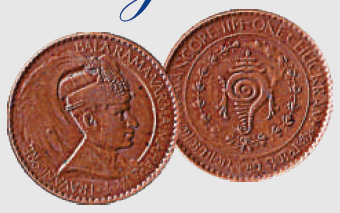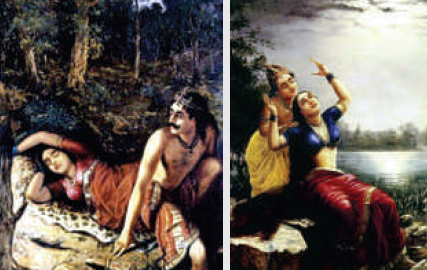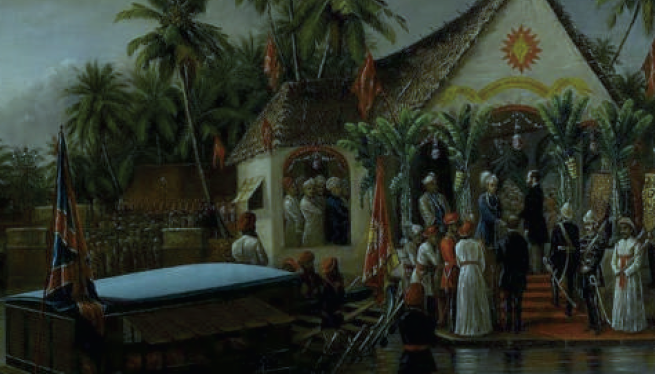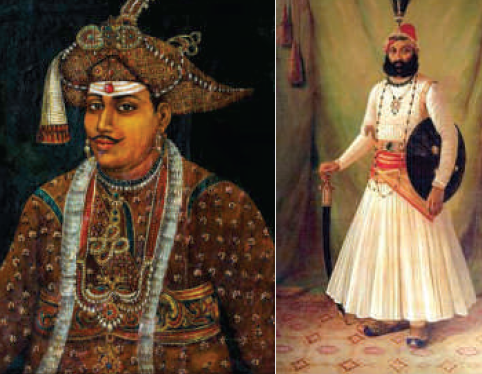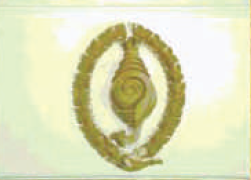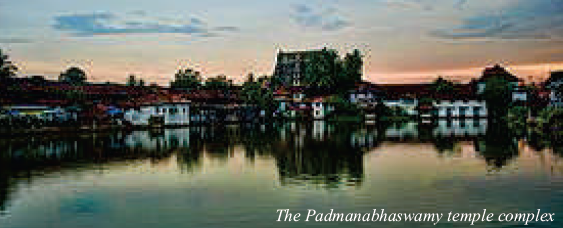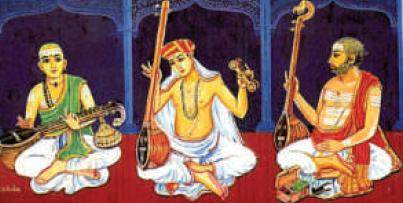The Travancore royal family
This is a collection of articles archived for the excellence of their content. Readers will be able to edit existing articles and post new articles directly |
Contents |
The Travancore royal family
Patrons Of Art And Music To The Present Day
By Dr. V.K. Gardner
India Harmony Volume - 2 : Issue - 1, 2013
There comes a time in the life of nations and nascent States when the artistic endeavours of the men and women who administer power, or who are born in influential families, impact indelibly upon the cultural contours of its artistic history and alter the course of its destiny in the perceptive framework of a more comprehensive artistic idiom.
““An artist who is credited with bringing about a momentous turn in the art of India, Raja Ravi Varma inexorably influenced future generations of artists from different streams. He was the first artist to cast the Indian Gods and mythological characters in natural earthy surroundings using a European realism; a depiction adopted not only by the Indian “calendar-art”- spawning ubiquitous images of Gods and Goddesses, but also by literature and later by the Indian film industryaffecting their dress and form even today. “
Born in the princely State of Travancore as Ravi Varma of Thampuran, of Kilimanoor palace on the 29th of April, 1848, Raja Ravi Varma secured the royal patronage of Ayilyam Thurunal of Travancore at an early age and began formal training thereafter. Belonging to a distinguished family – his father, Ezhumavail Neelakanthan Bhattatiripad was an accomplished scholar and his mother, Umayamba Thampuratti, was a poet and writer whose significant scholastic contribution, Parvati Swayamvaram, an informative treatise on the Tullal dance form, was published posthumously – it was almost a foregone conclusion that Raja Ravi Varma would one day shine on the firament of Indian Fine Arts!
Trained in water painting by Rama Swami Naidu, and later in oil painting by Dutch portraitist Theodor Jenson, he achieved the acme of artistic excellence with surprising swiftness! “His dazzling oil paintings of India's ancient glory delighted turn-of-the-century India and his mass reproductions through oleography reached out to the Indian populace in an unprecedented scale” – stunning the admiring gazes of later viewers with the voluptuousness of the Indian female form depicted in such perfect contoured proportion and with such a vivid burst of colour, that the visual images remained long after the physical (and pleasurable) assault on the eyes was over! Of course the feminine form was not the only focus of his artistic attention – mythical figures, demi-gods and Gods from the Indian pantheon also peopled his arresting works of art, creating a vast canvas of artistic achievement which was as appealing as it was authentic, as arresting as it was ample in quantification.
But I digress….Let us travel back in time to that auspicious time when this illustrious artist was born and the significant forces that gave rise to his artistic “oeuvres”, culminating in works to thrill the connoisseur of art as much as they provided pleasure to the aspiring student of art!
Privileged enough to be born into a family of scholars, poets and artists, even as a young boy he filled the walls of his home with a profusion of colorful pictures of animals and vignettes from his daily life, unconsciously displaying his skill in a medium which would later acquire magnificence! His indisputable talent was noted by his uncle, Raja Raja Varma, who himself was a proponent of the famous Tanjore art form. Persevering, he gave him his first few valuable lessons in art and continued to take a further interest in his further training and education, harnessing the royal patronage of the then ruling king, Ayilyam Thirunal.
Ravi Varma had been using the indigenous paints made from leaves, flowers, tree bark and soil which his uncle Raja Raja Varma prepared for him so diligently. Came another dilemma and he was faced with the challenge of using his first set of oil paints, brought from Madras after noticing a newspaper advertisement. Excited and nervous, he handled the paints he had waited such a long time for, with a degree of trepidation!
Though fully conversant with the art of painting, he was faced with the challenge of working in a medium which was very new and the technique equally elusive in those days! Only one person in Travancore knew the technique of oil painting and that happened to be Ramaswamy Naicker of Madura, who, recognizing a potential rival in Varma, refused to teach him the knowhow! Naicker's student, Arumugham Pillai however, would actually sneak into Moodath Madam House at nightfall to share his knowledge with Varma, much against his teacher's wishes. So began a cycle of clandestine but constructive artistic instruction!
Raja Ravi Varma's sojourn to the Moodath Madam house of the Kilimanoor Palace in Thiruvananthapuram at the tender age of 14, thus proved to be a multi-faceted boon! Not only did the palace painter instruct him in the art of water painting, but Ayilyam's nurturing of his artistic perceptions also exposed him to the famous paintings of Italian painters!
Thus, with the influence of the West, Raja Ravi Varma not only acquired new materials and new techniques, completely convinced of their power and serviceability, but through self-instruction and bold experimentation, mastered the complicated art of mixing colours! He painted with a passion he had not known existed and executed works which displayed a marvellous maturity.
“He painted both portraits and landscapes and introduced new elements into Indian painting. For the first time in the annals of Indian art, he had mastered and introduced the principle of perspective, the usage of canvas and oil colours. He brought in a perfect blend of European Academic realism and the true spirit of the Indian context.”
The innumerable pictures of Gods and Goddesses painted by Raja Ravi Varma which adorn most of the Hindu homes all over India, are even today objects of mass worship! Raja Ravi Varma's own sister, Mangalabhai Tampuratti, specialised herself in painting pictures of women and children which won universal appreciation from connoisseurs of art.
Music has often been known to inspire and promote a greater artistic finesse, imbuing it with an eloquence of expression and execution which enhances its appeal. Ravi Varma's creativity was further tempered by ecstatically listening to the music of veterans, watching Kathakali performances with rapt attention, going through the manuscripts preserved in ancient families and listening to the artistic interpretations of the epics.
Ravi Varma's fame as a portrait artist soared with several important portrait commissions from the Indian aristocracy and British officials between 1870 and 1878, and the sensitivity and immense competence of this artist still remains unsurpassed! However, before his roller-coaster ride to fame and fortune began, before the plaudits rolled in, in abundant measure, another significant event took place.........
His marriage, in 1866, to Pooroouttati Naal Tampuratty of Mavelikkara Kottaram Royal family and its attendant social status brought him into contact with the British Resident at Trivandrum and opened up the avenues of greater national and international exposure!
It was the Resident who persuaded him to participate in the Fine Art Exhibition, Madras in 1873. His work titled "A Nair Lady at the Toilet" showing a pretty woman adoring her hair with a garland of jasmine was adjudged to be the best! Wooing audiences, winning the Governor's Gold Medal, feted and felicitated by Governors and kings, he shot to fame!
“The Painter Prince” as he was somewhat romantically known, had begun to brighten the horizons of artistic endeavour, both in the country whose rich cultural heritage nurtured him, and the world beyond, which beckoned to him to explore world vistas!
The recognition that Ravi Varma received in major exhibitions abroad was for his evocative portrait-based renditions, which were meticulous compositions of people, their demeanor and attires. These works finely blended the elements of the early Tanjore custom of painting Nayikas and the graceful realism of European masters.
In the year 1873 Ravi Varma became a world famous Indian painter after winning honors in the prestigious international Vienna Exhibition. Though not really qualified for the title of a Raja, when an imperial citation happened to come across in the name of Raja Ravi Varma, the appellation stuck and stayed, suitably earned! Besides portraits, and portrait-based compositions, Varma now assiduously embarked on honing an oeuvre for theatrical compositions based on Indian myths and legends!
Painting over two dozen large canvasses depicting episodes from the Mahabharata and Ramayana, he worked with an impassioned fervor, creating his best works of art!
Thus several paintings like Nala and Damayanti, Radha & Madhava, Arjuna and Subhadra, Bharata, Shantanu and Ganga, Shantanu and Matsyagandhi, Vishwamitra and Menaka, Krishria Drishtha, Radha waiting for Krishna in Brindavan, Shakuntala writing letter with two sakhis, Mitrayani & Priyamvada and Urvashi, Sleeping Beauty, Lakshmi and Saraswati, acquired spectacular new dimensions under his skilful brush.
Executed during his ceremonial stay at the palace of Baroda, where he had been especially invited in 1881 by Sir R. Madhvarao, the British Regent to the State of Baroda, to commission the ceremonial portrait of Sayajirao III, the Gaekwad of Baroda, he was actively assisted by his brother, C. Raja Raja Varma, and sister Mangalabai Tampuratty, in this artistic venture. They adorn, with pride and perfection, the regal walls of Lakshmi Vilas Palace and Museum in Baroda, side by side with a significant number of family portraits of the royal Gaekwads, also done by Raja Ravi Varma!
The various assignments from the Gaekwad of Baroda brought Ravi Varma much renown and fame! Princes from different native states of India sought his services and he was invited to Bhavnagar, Puddukkottai, Mysore, Bikaner, and Jaipur to revive pictorial art history in their states. Though born in Travancore, he was the first of a new generation of Indian artists to cross regional barriers in receiving commissions and executing paintings on a pan Indian level.
And thus it was when we visited the resplendent Palace in Mysore some 25 years ago, we were treated to a visual feast of life-sized portraits of the erstwhile Maharaja of Mysore, Sri Chamarajendra Wodeyar and members of his royal family. Adorning the Jagmohan Palace Art Gallery, they had been executed during 1885, when the artist was invited for a royal visit, given a mansion to live in and regaled with music, dances and plays every night at the royal palace! On the eve of his departure, after a richly productive three month period, the Maharaja lined up his retinue of royal elephants and asked Raja Ravi Varma to choose two, which were later sent to Kilimanoor! Such was the largesse of living and giving in those gracious times!
With oil paints applied thickly, Ravi Varma created “lustrous, impasted jewellery, brocaded textures, and subtle shades of complexions.” Though several folk and traditional art forms of India since time immemorial “subsisted as illustrations for religious narratives, yet, illusionist paintings as a medium for story telling was Ravi Varma's invention.”
There was no greater artist than Ravi Varma either during his lifetime or in Indian Art History. Tributes came in from various places and people. Perhaps the most memorable is by Dr. Abanindranath Tagore, a revered name in Indian art, "it is rare to come across men like him, artists like him.
Swathi Thirunal Varma
Privileged to belong to the same illustrious Royal family of Travancore is Sri Swathi Thirunal Varma, the Maharaja of Travancore from April 16, 1813 to December 25, 1846 and a great patron of music.
A great musician himself, Sri Swathi Thirunal Rama Varma encouraged both broad systems of Indian music, Hindustani and Carnatic music. Essentially a connoisseur of the Carnatic music tradition, he is credited with over 400 compositions in both Carnatic and Hindustani music. Some of his favorite compositions include Padmanabha Pahi, Deva Deva, Sarasijanabha and Sree Ramana Vibho.
Evincing a deep interest in music right from his childhood, Swathi Thirunal, whose education was keenly supervised by his mother, herself a musician, his father, who was a Sanskrit scholar and his aunt Maharani Gowri Parvati Bayi, tried to learn the languages in which he found good music! Fluent in an impressive number of languages including Malayalam, Marathi, Sanskrit, Hindi, Bengali, Telugu, Kannada, Tamil, Oriya and English, he even knew Persian! His education in music started with the first lessons from Karamana Subrahmania Bhagavathar and Karamana Padmanabha Bhagavathar. Later, he studied music from his English teacher Subbarao. A self-taught musician to some extent, he continued to learn music by listening to accomplished musicians and practicing himself, honing the finer points of the art! Living during the golden era of Carnatic music, this was a period when music and art were thriving in many parts of south India. The triumvirate of Carnatic music, Tyagaraja (1767–1847), Syama Sastri (1762–1827) and Muthuswami Dikshitar (1775–1835), lived and enriched music greatly through their renditions, during this period. Swati Tirunal's palace was also home to many notable musicians and artistes of the period, including the famous Thanjavur Quartet brothers, Tyagaraja's disciple Kannayya Bhagavathar, Ananthapadmanabha Goswami (a Maharashtrian singer known as Kokilakanthameru swami),Shadkala Govinda Marar, and many others.
Prince Rama Varma, the South Indian Classical Musician, who is a descendent of Maharaja Swathi Thirunal, organises the highly reputed Swathi Sangeethotsavam, a week long music festival featuring exclusively the compositions of Swathi Thirunal. This unique musical event is conducted every year from 6 to 12 January at Kuthira Malika, Trivandrum. Featuring both Hindustani and Carnatic classical music, it is conducted by His Highness Sir Rama Varma Maharaja of Travancore Trust under the helm of Prince Rama Varma. A musical odyssey to enchant music lovers, it is the culmination of the rich tradition of music and culture of the tremendous Travancore kings!
Battle for the royal temple
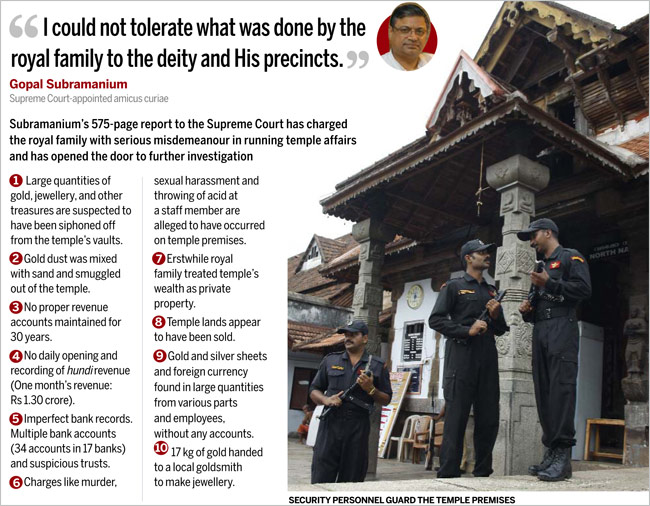

Supreme Court order forces the Travancore royal family to sever its 250-year-old ties with the Sree Padmanabhaswamy temple
M.G. Radhakrishnan
May 2, 2014
The scene was dramatic and emotional. Around 6 p.m. on April 27, Aditya Varma, 41, a senior member of the erstwhile royal family of Travancore, drove up in his white Honda City to the Sree Padmanabhaswamy Temple. Bare-bodied and barefoot as per temple tradition, Varma entered the temple, bowed to the devotees and temple staff and handed over a set of keys to the temple to K.P. Indira, district additional principal judge, Thiruvananthapuram. The keys included those to the famed temple's subterranean vaults, estimated to contain ancient treasures worth Rs.1 lakh crore. Supreme Court's verdict Varma's visit was prompted by an April 24 order of the Supreme Court bench comprising Justices R.M. Lodha and A. K. Patnaik which directed a five-member committee headed by the district judge to take over the temple's administration and, symbolically, the keys. The judge received the keys and issued a receipt to Varma, who has a family run business. He hid his emotions with a smile and raised his car keys to the onlookers: "This is the only key I have now."
The historic moment marked the severing of a 250-year-old umbilical cord between the royal family and the 1,000-year-old Vishnu temple. In 1750, Varma's ancestor, Marthanda Varma, the founder of the Travancore kingdom, declared himself a servant of Sree Padmanabhaswamy, inextricably linking his family's fortunes with that of the presiding deity. A 2011 revelation of treasure in its vaults, secretly stored in the temple by Marthanda Varma and his successors over two centuries, has made the temple one of the country's most heavily guarded shrines. It has 250 armed policemen and a series of sensors and metal detectors for which the state government has spent Rs.35 crore in the past two years.
Divine justiceDivine justiceThe apex court's directive came after an explosive 575-page report, filed on April 17 by senior advocate Gopal Subramanium, pointed out irregularities in the royal family-run temple. Subramanium was appointed amicus curiae or overseer by the Supreme Court in 2012 after a three-year-long case related to temple's administration. The former solicitor general's report pointed out massive pilferage of the temple's wealth and criminal acts alleged to have occurred on the premises over the past few years. The report blamed Uthradom Thirunal Marthanda Varma, the erstwhile royal family's head and the temple's trustee until his death in December 2013, as primarily responsible for most of the misdeeds at the shrine.
The Varma family has been kept out of a new five-member administrative committee appointed by the apex court on April 24 but this could be the first of many shocks in store. Subramanium did not rule out prosecution of the royal family if found guilty. "Everything will be decided according to the law of the land," he told INDIA TODAY.
The apex court also directed Vinod Rai, ex-comptroller and accountant general, to conduct an audit of the temple's accounts of the past 25 years. Rai has expressed his willingness but it isn't clear when he will commence work.
The amicus curiae's appointment followed a series of court cases that began with a 2007 petition filed in the Trivandrum Principal Sub Court by T.P. Sundararajan, a devotee and former IPS officer who died in 2011, saying the royal family was trying to make the temple its private property.
The deceased head of the royal family filed a special leave petition (SLP) against a 2011 Kerala High Court order which asked for the temple to be taken over by the state government. The sub court ruled in Sundararajan's favour, a decision that was upheld by the district and the state high court. The high court's division bench said in January 2011 that though the temple was administered by the last ruler as per the covenant signed in 1949 by the Government of India and the erstwhile royal family, its ownership was with the state government after the death of the last ruler in 1991.
The court issued an interim stay on this order on Varma's SLP but ordered the opening of the temple's vaults under the supervision of an expert committee and that an inventory be made. It was while this committee opened the vaults that the ancient treasures buried inside for centuries came into the public light for the first time. One of the six vaults will be opened this week, which will yield a firm figure to total worth of the temple treasures.
The amicus curiae directed that the royal family be allowed only to offer prayers or suggestions to the new committee. The report said huge amounts of cash, foreign currency, gold, silver and ornaments appear to have been pilfered from the temple. The report was finalised after Subramanium's two-year-long study culminating in a 35 days' continuous stay in Thiruvananthapuram from early March to early April. He flew into the city in a private jet, stayed at a five star hotel-all at his own expense-foregoing a month's practice in Delhi.
An ardent devotee, Subramanium was shocked to see the temple's shabby maintenance and even offered Rs.1 crore to clean up the temple pond after his order was ignored by the state government. He also called for investigation into the shocking criminal deeds alleged to have occurred at the temple, such as a case of sexual assault against a woman employee in 2009, throwing of acid against an employee who opposed misdeeds in 2007 and the discovery of a body in the temple tank last year. "These incidents need thorough investigation," says Subramanium. "Given what has been happening in the temple, the family is not entitled to be part of it anymore," he adds.
Though the royal family questioned the amicus curiae's report in the apex court, it has kept mum in public. "Lord Padmanabha is everything for us. Nobody in our family would dare to take a penny of His wealth," says Gouri Parvathi Bai, the family's eldest woman. Her younger sister Gouri Lakshmi Bai, who has written a book on the temple, says, "The Lord knows everything. He will clear our name."
Their only brother, Rama Varma, is the new head of the family after their uncle Marthanda Varma passed away in December. Rama Varma is the managing director of Aspinwall & Co, the family-run public limited company based in Mangalore and involved in shipping, logistics, plantations as well as tourism with annual revenue of Rs.100 crore. The family also owns extensive land and properties in Bangalore and Chennai besides palaces in Thiruvananthapuram.
Subramanium's report has divided members of the Supreme Court-appointed panel that prepared the inventory of assets in the chambers of the temple. While C.V. Ananda Bose, a retired IAS official and former head of the panel, endorsed the report, C.S. Rajan, another member and former high court judge, said no pilferage occurred after 2007 as the vaults were entrusted to two court-appointed officials.
The amicus curiae's report has left Kerala shell-shocked. Most people continue to hold the erstwhile royal family in high regard and are not convinced about its alleged culpability. "The royal family has protected the temple for long. It is unfair to accuse them without evidence," says V. Muraleedharan, BJP state president. BJP and Hindu groups have opposed a bigger government role in temple administration. Fearing Hindu ire, even the Congress-led United Democratic Front has toed a soft line. "We will go by whatever the Supreme Court says. But we will not allow the royal family to be humiliated," says Chief Minister Oommen Chandy.
CPI(M) Opposition leader V.S. Achuthanandan, 91, the sole surviving participant of a 1946 anti-royalty peasant uprising, however attacks the Congress for going soft on "an intolerant and exploitative royal family". "The family did not want Travancore to join India until the masses forced them to change. The CM referring to them as 'royal family' is against the Constitution," he says. Subramanium too attacked the state government in his report: "It is incredible that in a free republican country, the state and its officials recognise such an exceptional royal presence." With royalty now banished from the temple precincts, the court reigns supreme.
Subramanium's 575-page report to the Supreme Court has charged the royal family with serious misdemeanour in running temple affairs and has opened the door to further investigation Large quantities of gold, jewellery, and other treasures are suspected to have been siphoned off from the temple's vaults. Gold dust was mixed with sand and smuggled out of the temple. No proper revenue accounts maintained for 30 years. No daily opening and recording of hundi revenue (One month's revenue: Rs.1.30 crore). Charges like murder, sexual harassment and throwing of acid at a staff member are alleged to have occurred on temple premises. Erstwhile royal family treated temple's wealth as private property. Temple lands appear to have been sold. Gold and silver sheets and foreign currency found in large quantities from various parts and employees, without any accounts.
HISTORY
18th century Travancore king pledges crown to the temple. Travancore royal family takes over 10-century old temple, converts it into a shrine.
1950 Accession agreement between the Government and Travancore state vests the temple with the Travancore royal family's trust.
Case
2007 December 7 Thiruvananthapuram court says royal family has no right over temple, upholds ex-IPS T.P. Sundararajan's petition that its treasures were being pilfered.
2011 January 11 Kerala High Court directs the state government to take over the temple.
May 2 Supreme Court (SC) issues interim stay on high court order, upon special leave petition by Uthradom Thirunal Marthanda Varma, temple trustee and royal family head.
June Temple's underground vaults opened as per SC order. Unofficial estimate of treasure put at Rs.1 lakh crore.
2012 August Supreme Court appoints Gopal Subramanium an amicus curiae in the case.
2014 April 17 Report by amicus curiae points at irregularities in temple administration.
April 24 SC orders administration to be handed over to a 5-member committee headed by the district judge.
April 27 Erstwhile royal family hands over vault keys to the district judge.

